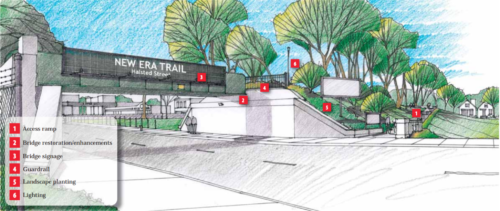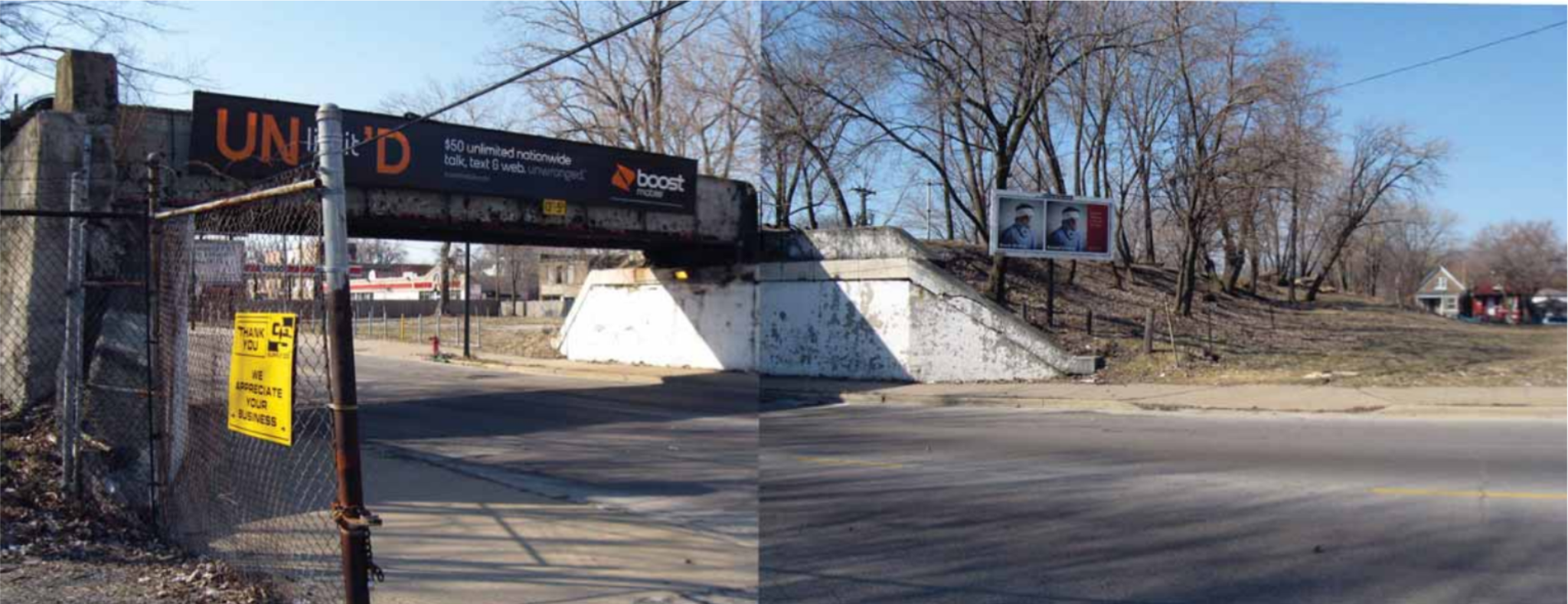Over a hundred protesters, supported by the Logan Square Neighborhood Association, marched along the 606 Trail on May 17. An elevated bicycle trail built on an abandoned railway stretching from Humboldt Park to Logan Square, the 606 Trail is an integral piece of Mayor Rahm Emanuel’s “Building on Burnham” plan. “Building on Burnham,” implemented more than a century after the 1909 Burnham Plan of Chicago, is a wide-reaching project in urban renewal that purports to “bring the spirit and benefits of Burnham’s original plan to every resident of Chicago.” To many low- and middle-income Chicagoans living near the trail, however, Emanuel’s bold vision of revitalizing their neighborhoods has fallen short. After the steady rise of rent in Logan Square over the last few years, and the city’s record property tax hike last October, many residents feel forced to leave their neighborhood just after the trail—and the beautification and renewal it brought with it—came to the area this past June.
Similar fears of gentrification, among other pressing concerns, have plagued two ongoing projects on the South Side that seek to convert largely abandoned railways to bicycle and nature trails: the Paseo in Pilsen and Little Village, and the Englewood Line Nature Trail.
The Paseo, a trail slated to be four miles long, starting at the intersection of 16th Street and Sangamon Street and heading southwest to Central Park Avenue, was officially announced by Emanuel in March. The Paseo will take the place of the disused Burlington Northern Santa Fe (BNSF) railway, which is, unlike the 606 Trail, at ground level. Besides separate walking and biking paths, the Paseo will be home to lush greenery, public art installations, and community gardens, with the first stretch of the trail along Sangamon to be completed by the end of this summer.
Many residents and community stakeholders, however, have voiced concerns over the Paseo’s potential for fueling gentrification, a problem that has beleaguered Pilsen in recent years. These fears are informed by the experience of residents living in the proximity of the 606 Trail—in Logan Square, where the median home sale price is $260,700 according to Zillow. Plans were announced this January for town houses one block south of the trail, priced at $929,000 each. While the Paseo is significantly cheaper, there are fears that it could accelerate the proliferation of high-end housing and retail in Pilsen and launch gentrification in Little Village, a comparatively lower-income neighborhood.
Representatives from nonprofit organizations such as the Little Village Environmental Justice Organization, Latinos Progresando, and Openlands have expressed their belief in the importance of keeping property prices and rents affordable in the immediate vicinity of the Paseo. These organizations, along with concerned residents, brought up the problem of gentrification in a community meeting on March 16, organized by the Chicago Department of Transportation, in an effort to involve homeowners and community stakeholders in the planning process.
In light of concerns about gentrification in Pilsen and Little Village, Juan Carlos Linares, director of Humboldt Park’s Latin United Community Housing Association, has suggested that lessons learned from the 606 Trail could be applied to the Paseo. For instance, Neighborhood Housing Services of Chicago has implemented a “forgivable” loan scheme for longtime residents of Humboldt Park and Logan Square living within two blocks of the 606 Trail, in which families may apply for up to $25,000 to cope with rising costs in the area.
Residents and organizers who participated in the aforementioned protests related to the 606 Trail, however, still consider these measures insufficient. Ordinances proposed by the Logan Square Neighborhood Association include determining property tax rebates based on income rather than home value, and the imposition of higher demolition fees to reduce the rate of construction in the affected areas. In light of these problems with the 606 Trail, the city has yet to conclusively answer the questions posed by the community about the further gentrification of Pilsen and Little Village, even as further planning and construction on the first section of the trail is underway.
The Englewood Line Nature Trail, which used to be called the Englewood Remaking America Trail, seems to be facing a different problem: institutional inertia. A two-mile elevated trail to be constructed in place of the abandoned railway between 58th and 59th Streets from Wallace Avenue stretching west to Hoyne Avenue, the proposed Englewood trail is intended to be “a community landmark and signature destination that enhances Englewood’s image,” according to a 2009 proposal submitted by the Hitchcock Design Group to Openlands, the nonprofit also involved in conversations about the Paseo trail.

Progress on the project, however, has been limited. The Green Healthy Neighborhoods Plan of the city’s Department of Planning and Development recommended the conversion of the railway into a nature trail in 2005, and Sustainable Englewood Initiatives identified the Norfolk Southern railway for potential recreational use in 2007, but the land is still in the process of being acquired by the city. In 2014, the mayor’s office formally submitted an ordinance proposing land exchange in Englewood with Norfolk Southern, but the present status of the deal remains ambiguous.
In 2013, the Chicago Plan Commission approved the city’s ceding of land in Englewood to Norfolk Southern to expand their rail yard in return for their derelict railway tracks. This deal will add eighty-four acres to the corporation’s current rail yard holdings and purports to bring four hundred jobs to Englewood. In the process of the deal, however, there has been substantial resistance from local homeowners. The Englewood Railway Coalition was formed in 2011 as a nonprofit organization to assist these homeowners, numbering twenty-two as of 2015, in resisting the massive buyout schemes and other measures taken by Norfolk Southern in a bid to expand their operations in Englewood.
Considering that this deal appears to be the linchpin of the entire Englewood Line Nature Trail enterprise, it seems unlikely that the trail will make much progress in the days ahead. In spite of this, several community organizations, including the Active Transportation Alliance, Grow Greater Englewood, and the urban planning firm Teska Associates have come together to conduct conversations with community stakeholders and residents. The coalition held its first meeting in January, and discussed issues ranging from the safety of an elevated trail to possible amenities on the trail.
There is much optimism about the possibilities that this new development would open for Englewood, especially in its potential to “boost the local food system and economy,” as Sonya Harper, executive director of Grow Greater Englewood, put it during the January meeting. This attitude, however, was less prevalent in the community meeting about the Paseo, especially with the looming specter of rising rents and property taxes. As tensions around gentrification continue simmering unabated in Logan Square and Humboldt Park, and as questions about the future of low- and middle-income Chicagoans in these neighborhoods are left unanswered, the ways in which the Paseo will shape the fabric of Pilsen and Little Village are uncertain at best.


If they would only start the Paseo by expanding from the new La Villita park westward to the River, then it probably would add a neighborhood amenity without fueling massive price increases. The reason the 606 is causing price inflation is because it is linking an already gentrified area, to parts of 2 neighborhoods that have lacked transportation & recreational amenities. I have lived in Logan Square & Humboldt Park for 5 years & the trail has made it easier to justify living west of Kedzie as rent increases have priced me out of previous apartments while I still want to stay in the neighborhood.
Build the Paseo in Little Village before 20 somethings like myself are living in large numbers west of Western. If you build it from the east to west, it will just draw people who already live in Pilsen & Bridgeport to search for cheaper rent in Heart of Chicago, & then later Little Village. See how the Major Taylor Trail hasn’t caused gentrification? It, like the proposed Paseo, does not have grade separated street crossings, but it connects Beverly to West Pullman.
Also, thank you for these posts, they are a welcome addition to the discussions across this city.